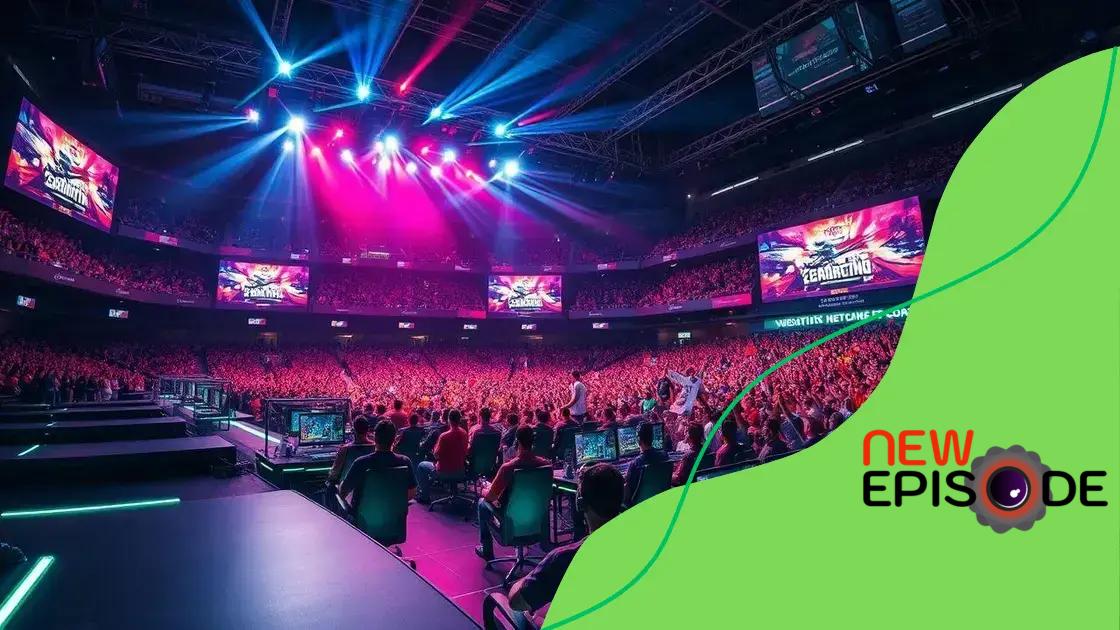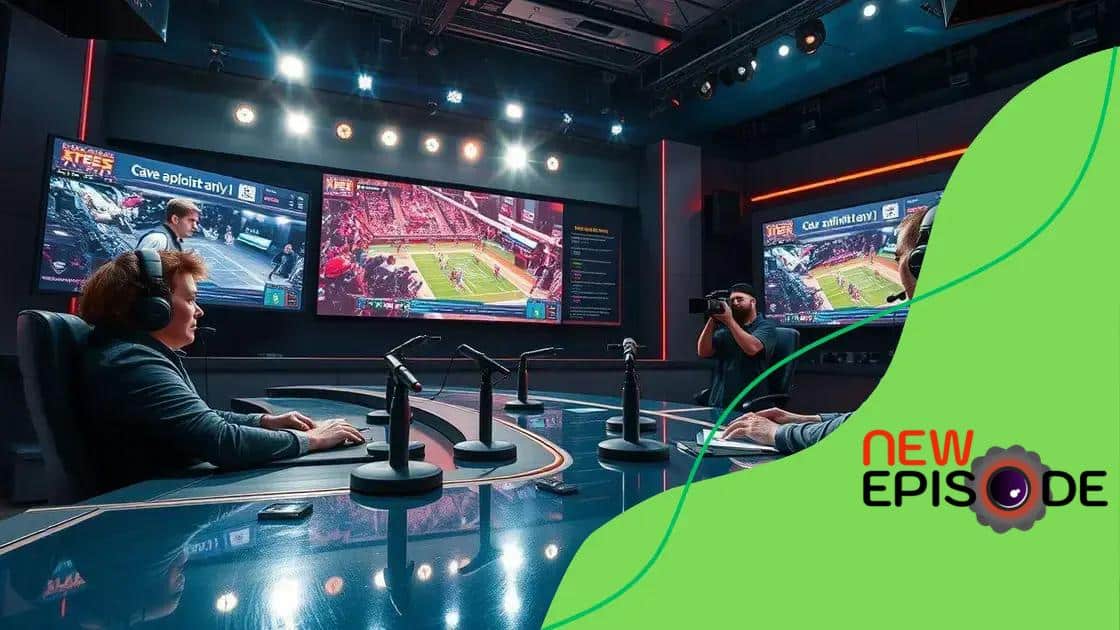How e-sports are influencing mainstream media content

How e-sports are influencing mainstream media content includes increased viewership, brand partnerships, and innovative advertising strategies, making e-sports a significant part of the modern entertainment landscape.
How e-sports are influencing mainstream media content is a question many have begun to explore. As gaming takes center stage, it’s fascinating to see how this phenomenon reshapes our media landscape. Let’s dive into the implications!
The rise of e-sports in popular culture
The rise of e-sports in popular culture is reshaping how audiences engage with entertainment. Over the past decade, we’ve witnessed a surge in the popularity of competitive gaming, drawing in millions of fans around the globe. This phenomenon goes beyond mere gaming; it has become a cultural touchstone that influences various aspects of our lives.
Impact on Youth Engagement
As e-sports gain traction, they attract a younger audience who are eager to participate. This engagement is evident in schools and universities, where e-sports teams are becoming commonplace. Students find a sense of community and belonging through competitive gaming.
- Establishment of e-sports clubs in schools.
- Increased interest in gaming as a career.
- Collaboration between schools and e-sports organizations.
Moreover, the accessibility of streaming platforms enhances this connectivity. Viewers can watch their favorite players live, creating a bond between gamers and fans. Platforms like Twitch and YouTube Gaming have become key players in the industry, making it easier for fans to engage with content they love.
Crossover with Traditional Media
Another significant aspect of the rise of e-sports is its crossover with traditional media. Major networks are beginning to broadcast e-sports events, treating them as legitimate sporting competitions. This shift represents a broader acceptance of competitive gaming in the mainstream.
Brand collaborations are also on the rise. Companies are increasingly sponsoring e-sports teams, leading to innovative marketing strategies. This collaboration opens new avenues for advertisers to reach the tech-savvy demographic that follows gaming.
- Sponsorship deals with major brands.
- Collaborative events between e-sports and traditional sports.
- Increased visibility in media outlets.
As e-sports continue to evolve, it will be interesting to see how they further integrate into mainstream culture. The influence of gaming on music, fashion, and film indicates that this industry is not a passing trend, but a lasting part of our entertainment landscape.
How e-sports are changing media narratives
How e-sports are changing media narratives is evident across various platforms and genres. This shift reflects greater acceptance and recognition of gaming as not just a hobby, but a significant part of modern culture. We can see this influence in storytelling, format, and even audience engagement.
New Storytelling Techniques
E-sports introduce unique storytelling techniques that differ from traditional media. For instance, the personal journeys of players become narratives that fans eagerly follow. The rise of streaming platforms has made this possible, allowing gamers to share their experiences live.
- Live commentary during matches builds excitement.
- Documentaries about players highlight their struggles and achievements.
- Interactive content engages fans in real-time.
This shift creates a new dimension in how stories are told. Fans are not just passive viewers; they participate in shaping the narrative by engaging with their favorite players on social media or through comments during live streams. This dynamic creates a community where every match feels like a shared experience.
Influence on Journalism
The way traditional media covers e-sports has also evolved. News outlets now dedicate sections to gaming, providing timely updates on tournaments and player performances. This coverage often mirrors how sports are reported, complete with analysis and expert opinions.
As e-sports gain traction, they challenge conventional narratives found in sports journalism. Coverage is more inclusive, featuring diverse voices and perspectives. The vibrant discussions surrounding e-sports, including strategies and player interactions, enrich the media landscape.
- Increased columns and articles focusing on gaming.
- Collaboration between e-sports organizations and media outlets.
- Analysis of gaming strategies becomes more mainstream.
These developments illustrate how e-sports are not just changing narratives but also enriching the very fabric of media itself. As audiences crave more authentic and interactive experiences, the inclusion of e-sports in media reflects a broader trend toward acceptance of this cultural phenomenon.
Impact on traditional sports coverage

The impact of e-sports on traditional sports coverage is significant and evolving. As e-sports gain popularity, traditional media outlets are adapting to incorporate this new form of entertainment into their programming. This change reflects the growing interest in competitive gaming as a legitimate sport.
Shifting Focus in Coverage
Traditional sports networks are now dedicating airtime to e-sports. This shift results in more comprehensive coverage, similar to how they report on conventional sports. By broadcasting e-sports tournaments, networks reach younger audiences who are more engaged in gaming.
- Live broadcasting of major tournaments is becoming common.
- Analysis and commentary are provided by experts in the field.
- Highlight reels showcase exciting gameplay moments.
Moreover, traditional sports analysts are beginning to view e-sports in the same light as conventional sports. This acceptance encourages a deeper analysis of gaming strategies and player performances, similar to what audiences expect from traditional sports coverage.
Collaboration with E-sports Organizations
Collaborations between e-sports organizations and traditional sports teams are on the rise. This partnership leads to crossover events, where fans of both e-sports and traditional sports can engage with content in new ways. These events often draw large audiences, proving that interest in e-sports is not a niche but a growing mainstream phenomenon.
For example, some sports franchises are establishing their own e-sports teams. This strategy engages loyal fans and attracts a new generation of sports enthusiasts. It creates a unique opportunity to blend gaming with traditional sports culture.
- Joint events between traditional sports and e-sports.
- Increased sponsorship opportunities for both sectors.
- Fan engagement strategies that target diverse audiences.
The integration of e-sports presents exciting opportunities for traditional sports media. As coverage continues to evolve, it remains clear that the interests of the new generation of fans will shape how we engage with sports in the future.
E-sports and advertising trends
E-sports and advertising trends are closely linked as brands begin to recognize the potential of this growing market. As the popularity of competitive gaming increases, companies are shifting their marketing strategies to engage with a diverse and passionate audience.
Targeting a Young Demographic
One of the key reasons brands are investing in e-sports is the opportunity to reach a younger demographic. Many of these fans are highly engaged and interested in the products endorsed by their favorite gamers. This unique connection makes e-sports an attractive platform for advertisers.
- Millennials and Gen Z make up a large portion of the audience.
- Fans often seek recommendations from their favorite players.
- Brand loyalty is often stronger in this demographic.
By sponsoring events or players, companies can tap into this devoted fanbase and effectively promote their products.
Innovative Advertising Strategies
As e-sports evolve, so do the advertising strategies used. Traditional ads are being replaced with more integrated marketing techniques. For example, brands are creating in-game advertisements that blend seamlessly into gameplay. This method enhances user experience while still delivering brand messages.
Moreover, content creators and streamers often collaborate with brands for sponsored content. This partnership allows brands to reach audiences authentically, as fans appreciate the unfiltered perspective of their favorite gamers.
- In-game sponsorship placements increase visibility.
- Exclusive content for branded promotions builds excitement.
- Collaborations can lead to memorable marketing campaigns.
Such strategies not only enhance brand awareness but also create a more immersive experience for viewers. The integration of advertising into e-sports reflects how brands are adapting to new consumer behaviors and preferences.
Future projections for e-sports in media
Future projections for e-sports in media suggest a transformation that will continue to evolve over the coming years. As technology advances and audiences grow, the integration of e-sports into mainstream media will deepen.
Growth in Viewership
One key area of growth is anticipated in viewership. Current research indicates that e-sports audiences could surpass traditional sports in the near future. This surge is fueled by the increasing accessibility of streaming platforms and social media channels, where fans consume content regularly.
- Greater accessibility through mobile devices and apps.
- Expansion of high-speed internet globally.
- Increase in youth engagement with gaming as entertainment.
As more people discover e-sports, the potential for attracting advertisers and sponsors will also increase, further solidifying the industry’s position in media.
Integration with Traditional Sports
Another trend we may see is the greater integration of e-sports with traditional sports broadcasting. Major sports networks are already experimenting with broadcasting e-sports tournaments. As this trend grows, we can expect to see innovative hybrid events that combine elements of both realms, appealing to diverse audiences.
Collaborations between traditional sports teams and e-sports organizations are likely to become more common. This partnership can help traditional sports teams to tap into new fan bases while providing e-sports with the credibility and infrastructure of established sports.
- Joint events featuring gamers and traditional athletes.
- Shared marketing campaigns and sponsorships.
- Enhanced cross-platform viewing experiences.
The potential for e-sports to reshape sports media continues to grow as these possibilities develop. The influence of e-sports on popular culture is undeniable, and as it integrates further with traditional media, it will change how we perceive entertainment.
In conclusion, e-sports continue to grow as a significant part of mainstream media and culture. As traditional sports and e-sports converge, we see a new era of entertainment emerging. The influence of e-sports on advertising trends, audience engagement, and storytelling is reshaping how we consume content. With exciting future projections, e-sports are set to become an even more integral part of the media landscape. The connection between e-sports and mainstream culture is undeniable, and as this relationship deepens, it opens up new opportunities for fans and brands alike.
FAQ – Frequently Asked Questions about the Impact of E-sports on Media
How are e-sports changing traditional sports coverage?
E-sports are being integrated into traditional sports networks, offering live broadcasts of tournaments and attracting younger audiences.
What role do brands play in e-sports?
Brands are increasingly sponsoring e-sports events and teams, using innovative advertising strategies to reach a dedicated fan base.
Why is the audience for e-sports growing?
The rise of accessible streaming platforms and the popularity of competitive gaming among youth contribute to the increasing audience for e-sports.
What future trends can we expect in e-sports?
Future trends include more collaboration between traditional sports and e-sports, innovative content creation, and increased integration of advertising.






